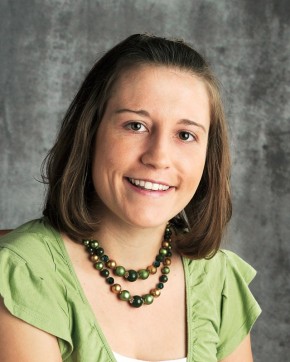Jessica Barnes
Alumni Spotlight
JESSICA ANDRESEN BARNES
Jessica Andresen Barnes teaches art at Orono High School thanks to University of Maine instructor Ed Nadeau who noticed her talent when she was a student in his drawing class.
‘”You should consider working with kids,’’’ Barnes said he suggested.
‘’‘Why not check out the art education program?’’’
“The more I thought about it, the more it appealed to me,” said Barnes, who earned her bachelor’s degree in art education in 2005 and her master’s degree in art education in 2010.
She’s glad now she took her instructor’s advice.
“I love teaching!” said Barnes, the only art teacher at Orono High School. She teaches painting, drawing, basic art, advanced art, sculpture, commercial art and AP art. “No two days are ever the same,” she said. “It’s been wonderful to be able to ignite a spark in students who initially didn’t have a passion for art. To see how excited they are about their projects at the end of the semester and hear them say, ‘I can’t believe I created this!’’’ is the reason I get up every day. It’s wonderful to be a mentor to students who are applying to art school. Being part of their college preparations has been really exciting.”
“No two days are ever the same,” she said. “It’s been wonderful to be able to ignite a spark in students who initially didn’t have a passion for art. To see how excited they are about their projects at the end of the semester and hear them say, ‘I can’t believe I created this!’’’ is the reason I get up every day. It’s wonderful to be a mentor to students who are applying to art school. Being part of their college preparations has been really exciting.”
Recalling her own supporters at the UMaine Department of Art, Barnes said Associate Professor of Art and Art Education Laurie Hicks guided her as she wrote her master’s thesis on censorship in art education. “She forced me to think outside of the box and make broader connections to what I was learning and doing. She was a great mentor who really pushed me achieve my fullest potential.”
Investigating the effects of censorship on K-12 public schools in Maine, Barnes found that censorship manifests itself in many forms, actively and passively finding its way into visual arts classrooms. All educators who participated in the study were aware of and admitted to self-censoring in the classroom. Barnes found that the major censors in Maine schools were community, parents, faculty and administrators, teachers, and students. Each censor played a different role in influencing the way art educators in Maine approached their curriculum.
Associate Professor of art and Art Education Constant Albertson also was a huge influence, according to Barnes who said she relied on her for pushing her out of her comfort zone. “She taught me to strive for excellence as a teacher and make sure what I was teaching was interesting and relevant. Every time I introduce a new lesson in my curriculum, I think back to what I learned in her classes”.
Barnes recalled a number of highlights as a UMaine art student. She received two art education awards for excellence, was selected for numerous juried art exhibits, and was nominated for the College of Liberal Arts and Science Outstanding Senior Award for her work with the Empty Bowls Project which requires students to make ceramic bowls, host a public supper, and then donate the proceeds to a local charity.
“I got an excellent art background at the University of Maine,” she said. “The biggest thing was the willingness of the professors to work one-on-one with us and make sure we were achieving our full potential.”
Nowadays, she spends as much time as possible in her home studio where she does fiber art and icon painting. In a technique she learned from her instructor, Ed Nadeau, she mixes her own paint by incorporating finely ground pigment and water with diluted egg yolk.
“I teach my students how to make egg tempera, too,” she said. “They get really excited when they use paint they’ve made themselves. It’s not done in many high school art classes.”
